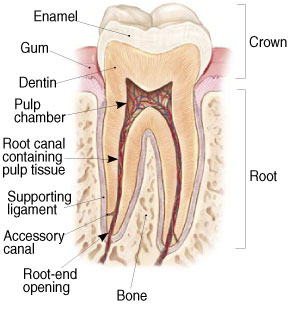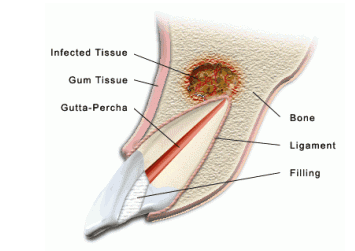 What is an Endodontist and what do they do?
What is an Endodontist and what do they do?
Endodontists are dentists who specialize in maintaining teeth through endodontic therapy — procedures, involving the soft inner tissue of the teeth, called the pulp. The word “endodontic” comes from “endo” meaning inside and “odont” meaning tooth. Like many medical terms, it’s Greek. All dentists are trained in diagnosis and endodontic therapy, however, some teeth can be especially difficult to diagnose and treat. That’s why you may have been referred to an endodontic specialist.
In addition to dental school, endodontists receive two or more years of advanced education in this kind of treatment. They study root canal techniques and procedures in greater depth, for diagnosis and treatment of more difficult cases. We also have very specialized equipment to facilitate more effective care. For this reason, many dentists choose to refer their patients to endodontists.
What is a root canal?
A root canal is one of the most common dental procedures with well over 14 million performed every year. This simple treatment can save your natural teeth and prevent the need for dental implants or bridges.
A root canal is a treatment used to repair and save a tooth that is badly decayed or becomes infected. During a root canal procedure, the nerve and pulp are removed and the inside of the tooth is cleaned and sealed. Without treatment, the tissue surrounding the tooth will become infected and abscesses may form.
“Root canal” is the term used to describe the natural cavity within the center of the tooth. The pulp or pulp chamber is the soft area within the root canal. The tooth’s nerve lies within the root canal.
A tooth’s nerve is not vitally important to a tooth’s health and function after the tooth has emerged through the gums. Its only function is sensory — to provide the sensation of hot or cold. The presence or absence of a nerve will not affect the day-to-day functioning of the tooth.
What happens during endodontic treatment?
 A local anesthetic will be given. A sheet of latex called a “rubber dam” (we’ve got nonlatex dams too) will be placed around the tooth to isolate it and keep it clean and dry during treatment. The treatment consists of three or four basic steps, but the number of visits will depend on your particular case. Some treatments take 2 visits but many are just a single visit. Occasionally 3 appointments are needed.
A local anesthetic will be given. A sheet of latex called a “rubber dam” (we’ve got nonlatex dams too) will be placed around the tooth to isolate it and keep it clean and dry during treatment. The treatment consists of three or four basic steps, but the number of visits will depend on your particular case. Some treatments take 2 visits but many are just a single visit. Occasionally 3 appointments are needed.
In any case, it depends on the degree of infection/inflammation and degree of treatment difficulty. To me, it’s more important to do it the very best we can then to meet a specific time criteria. Let’s look at the basic steps for nonsurgical endodontic therapy.
There are, of course, no guarantees. Root canal or endodontic therapy has a very high degree of success, up to 90%. Teeth which can be treated near ideal have a success rate up to ninety percent! We will discuss the chances of success before any endodontic procedure to help you make an informed decision. If a root canal or endodontic therapy is unsuccessful or fails you still have options.
An Endodontist diagnoses and treats pain.
Oral pain such as toothaches or cracked / fractured teeth can often be difficult to pinpoint. Because of the vast network of nerves in the mouth, the pain of a damaged or diseased tooth often is felt in another tooth and/or in the head, neck, or ear. An endodontist is a specialist in diagnosing and treating this type of pain.
An Endodontist treats traumatic injuries.
 Pulp damage is sometimes caused by a blow to the mouth, and the endodontist specializes in treating these traumatic injuries. For example, a blow to a child’s permanent tooth that is not fully developed can cause the root to stop growing. A procedure called apexification stimulates bone to be deposited at the end of the root which makes it possible to then save the tooth through a root canal procedure. An endodontist is specially trained in procedures for replanting teeth that have been knocked out of their sockets.
Pulp damage is sometimes caused by a blow to the mouth, and the endodontist specializes in treating these traumatic injuries. For example, a blow to a child’s permanent tooth that is not fully developed can cause the root to stop growing. A procedure called apexification stimulates bone to be deposited at the end of the root which makes it possible to then save the tooth through a root canal procedure. An endodontist is specially trained in procedures for replanting teeth that have been knocked out of their sockets.
Will I need to return to your office for Additional Visits?
Once endodontic therapy is completed your tooth should be examined periodically, usually every 6 – 12 months. This allows us to make sure the tooth has healed or is healing properly. You will be sent a notice in the mail when we feel it is appropriate to reevaluate the area. Since an abscess may take 2 years to heal, our office will reevaluate the tooth for at least 2 years.
Retreatment
Occasionally a tooth that has undergone endodontic treatment fails to heal or pain continues despite therapy. Although rare, sometimes a tooth initially responds to root canal therapy but becomes painful or diseased months or years later. When either of these situations occur, the tooth often can be maintained with a second endodontic treatment.
